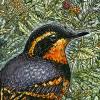

Join BirdNote tomorrow, November 30th!
Illustrator David Sibley and actor H. Jon Benjamin will face off in the bird illustration battle of the century during BirdNote's Year-end Celebration and Auction!
Horned Larks rival meadowlarks as the most colorful birds of North American grasslands. They live in prairies, fields, and tundra, but agriculture and development now intrude on many of the Horned Lark's traditional nesting areas. The farmland Conservation Reserve Program encourages agricultural landowners to plant resource-conserving vegetation. This practice protects topsoil and provides habitat for birds like the Horned Lark, as well as other wildlife.
BirdNote gives you the sounds of birds every day, and you can get the sights as well when you follow us on Instagram, @BirdNoteRadio.
BirdNote®
Hovering with Horned Larks
Written by Bob Sundstrom
This is BirdNote.
[Rapid tinkling song of Horned Lark]
A high-pitched, tinkling bird song floats across an open landscape of short grasses.
[Rapid tinkling song of Horned Lark]
But, strangely, there’s no singer in sight. Our bird, a male Horned Lark, is a hundred feet in the air — hovering, wings fluttering, circling against the blue sky.
[Horned Lark song]
Now, the bird is gliding steeply, headlong towards the ground, flaring its wings at the last instant to break the dive.
Horned Larks – roughly the size of sparrows – rival meadowlarks as the most colorful birds of North American grasslands. The male’s bright yellow face is framed by crisp black sideburns. And true to its name, the Horned Lark does have horns, of a sort. When in the mood, the male erects pointed black feathers above its eyes, giving it a devilish demeanor.
Horned Larks live in prairies, fields, and tundra. Agriculture and development now intrude on many of the Horned Lark’s traditional nesting areas. However, programs that replenish grasslands and set aside croplands can be a boon to this exquisite bird.
[Song of Horned Lark]
Learn more and see a picture of a Horned Lark at our website, BirdNote.org. BirdNote gives you the sounds of birds every day, and you can get the sights as well when you follow us on Instagram, at BirdNoteRadio.
I’m Mary McCann.
###
Bird sounds provided by The Macaulay Library at the Cornell Lab of Ornithology, Ithaca, New York. Recorded by G.A. Keller.
Producer: John Kessler; Managing Producer: Jason Saul; Editor: Ashley Ahearn; Associate Producer: Ellen Blackstone; Assistant Producer: Mark Bramhill.
© 2013 Tune In to Nature.org April 2013/2016/2019/2022 Narrator: Mary McCann
ID# SotB-HOLA-01-2019-04-20 was 042806HOLAKPLU SotB-HOLA-01b





